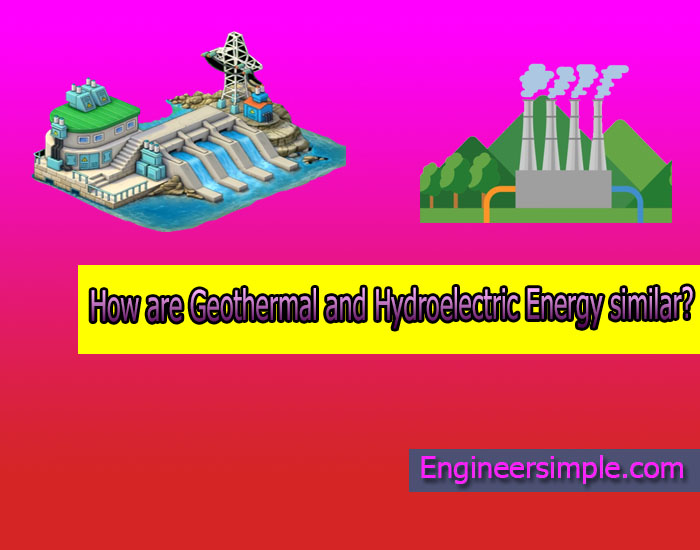How are Geothermal and Hydroelectric Energy similar?
Introduction
There
are some things that are the same between geothermal and hydroelectric
energies. Both deal with the process of harnessing the power of water, but there is a major difference in their process
of generation. So, to get a better understanding of how these two work,
I've put together this article to compare them and help you understand these
two types of renewable energy sources.
Both
geothermal and hydroelectric energy are generated from water, albeit at
different points in time. In some cases,
hydroelectric reservoirs have been used for millennia, while others have only
been developed in the last century or so. Both energy sources also rely on
natural geological conditions. Geothermal energy is generated as hot water
rises from deep within the earth to the surface and facilitates the extraction
of energy from thermal water (i.e., hot springs). Hydroelectric power plants
capture run-off rainfall or snowmelt that would otherwise flow away without
generating electricity.
Geothermal and hydroelectric
energy are both renewable sources of energy, as they do not emit greenhouse
gases into the atmosphere.
Read More-The possibility of generating electricity using hydroelectric power in Singapore
Both geothermal and hydroelectric
energy use a process called "geothermal heat pumps," which use water
to transfer thermal energy from one place to another. This is done by pumping
geothermal fluid through a heat exchanger, which transfers the fluid's thermal
energy from the ground to an output tank where it can be used for heating or
cooling. The heat exchanger uses either water or a liquid (such as propane) and
converts the temperature difference between two fluids into mechanical work.
This is then converted into useful power using a motor or generator.
The use of natural resources
Both
geothermal energy and hydroelectric energy come from the use of natural
resources.
Geothermal
energy is derived from the decay of radioactive elements within the earth's
crust, which are released by volcanic activity. Hydroelectric power is generated
by the force of water flowing against a fixed object, like a dam or waterfall.
Both
forms of renewable energy have an advantage over fossil fuels. Fossil fuels are non-renewable sources that
burn and release carbon dioxide into the atmosphere, causing climate change and
contributing to global warming. Renewable sources such as wind and solar
power, on the other hand, produce no harmful gases when they're used to
generate electricity.
Both forms of renewable energy can be
used in place of fossil fuels for many purposes. Geothermal
energy can be used for heating buildings or operating machinery in areas where
coal or natural gas would otherwise be burned for heat and electricity
production; hydroelectricity can be used to produce electricity at remote locations
where coal or natural gas would not be economically feasible due to their high
cost.
Renewable source
Both
are renewable sources. Both have been used to produce electricity since the
19th century, and both are still used today and both have a small land
footprint.
Hydroelectricity
is a form of renewable energy that provides
power by harnessing the kinetic energy of flowing water to create electricity.
This method is more efficient than other methods such as wind turbines or solar
panels, but it also has several
drawbacks such as high maintenance costs and the need for dams.
On the
other hand, geothermal electricity is
produced by using natural heat from the earth. This method is not as efficient
as hydroelectric power plants, but it has no environmental impact and does
not require any damming or excavation work.
Neither use fuel to generate power
The two
main types of energy are:
Fossil fuel – This is a
non-renewable resource that is formed from dead plants and animals. It is used
to generate electricity and heat in power stations.
Geothermal – This source of
energy comes from below the Earth’s
surface and can be used for heating, cooling or electricity generation.
Hydroelectricity
is similar to geothermal energy but it uses water falling down a stream or
river as its medium instead of hot water. Hydroelectric
power stations are also known as hydroelectric dams.
Clean sources of energy
Geothermal
energy and hydroelectric energy are clean sources of energy. Both are
renewable, and they produce no greenhouse gases. However, they have different
methods of generating electricity.
Hydroelectric
power has been used for hundreds of years. It involves using gravity to push
water into a turbine that spins a generator. The power is then sent through a
transmission line to your home or business.
Geothermal
energy comes from the Earth's interior and outer core. As hot rocks move
through the ground, they release heat energy, which can be harnessed to produce
electricity. Geothermal plants generally sit on top of active volcanoes, where
hot springs commonly occur near the surface within the Earth's crust.






